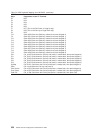QSYSINC Member Name: ETGDEVEX
Exit Point Name: QIBM_QTG_DEVINIT
Exit Point Format Name: INIT0100
The TELNET server will optionally provide for selecting or setting the device name
to be used over the TELNET session, and allow for a TELNET client to bypass
traditional device initialization. Administrators may control these new features
through the use of a new exit program, which will optionally start just after client
session establishment. Several parameters will be supplied to the exit program to
be used in the decision process, and the exit program can set or change various
parameters prior to returning to the TELNET server. You can optionally register a
second exit program to start just prior to session termination. You can use this
second exit program for session auditing or virtual device management.
Telnet Exit Point Format INIT0100: Required Parameter Group
User description information
I/O; CHAR(*) Information about the user that the system will use as part of the
auto-signon process.
Device description information
I/O; CHAR(*) Information that the system will use to create or change the
device that it uses for this TELNET session.
Connection description information
I/O; CHAR(*) Information about the client connection that the exit program can
use.
Environment options
INPUT; CHAR(*) An array containing all the RFC 1572 environment options
negotiated by the client. These will be in the exact format that they were in
when received from the client and specified by RFC 1572. The array will, in
general, consist of 1 or more pairs of environment variable names and
associated values. The RFC specifies that each variable name will always be
preceded by either an X’01’ or X’03’ depending on whether it is an RFC 1572
defined VAR, or an application specific defined USERVAR. If a value is to be
associated with a VAR (or USERVAR), that value will appear next in the array
preceded by the RFC 1572 defined VALUE character - X’01’. This sequence of
VAR/VALUE pairs will be repeated up to a maximum of 1024 total bytes of
negotiation data.
RFC 1572 and the more general TELNET negotiation RFCs also allow for
control characters to appear within the VAR/USERVAR variable names or their
associated values. This is allowed through the use of the ESC character X’02’
and rules that apply when the ESC character itself or TELNET IAC control
characters must appear in the negotiation sequence. Refer to RFC 1572 for a
more complete description of control character escaping rules.
Length of environment options
INPUT; BINARY(4) The Internet Protocol (IP) address that was just released
from its client host binding. This string is in dotted decimal format, left justified.
Allow connection
OUTPUT; CHAR(1) Applies to all devices and indicates to the TELNET server
whether it should allow the client to connect. If the device type is DISPLAY and
you have enabled auto-signon, then this client may also bypass the sign-on
panel on the AS/400. The valid values are as follows:
0 Reject the request from the client
542 OS/400 TCP/IP Configuration and Reference V4R4


















